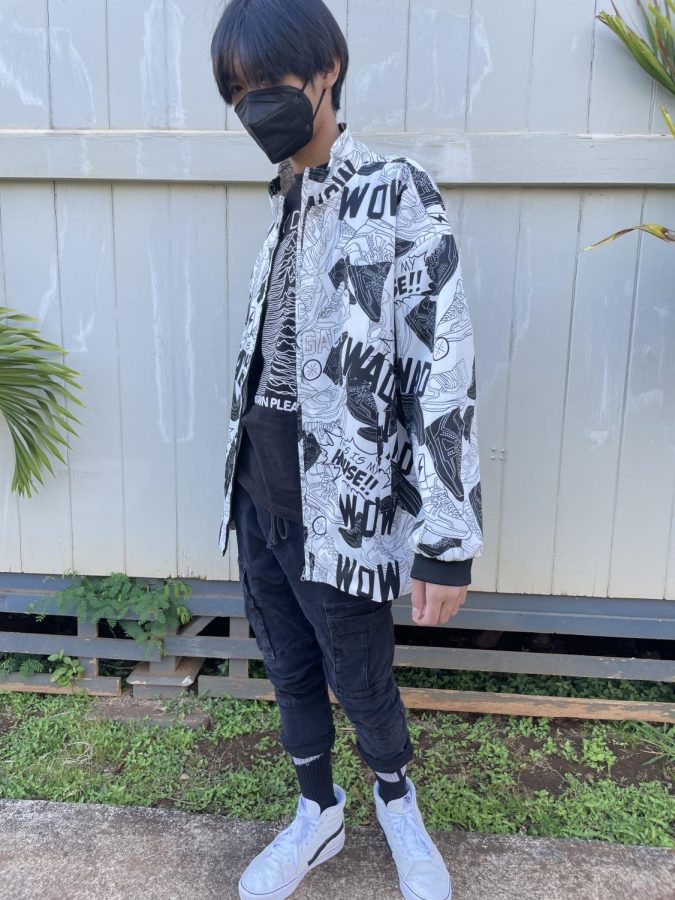The price of cheap, “fast” fashion is actually steep
Sophomore Dustin Ibanez models a Shein jacket.
May 5, 2022
The world is quite impatient, especially with the normalcy of using the internet. If a video on Instagram is “too long” and not fast enough to get to the punch line, a quick swipe to the next thing on the feed can give an instant laugh. Trends, whether it be songs or fashion pieces, go over the same way; people always want something more, even after being interested in something for only a small period of time.
When constantly changing fixations apply to the fashion industry, paired with the need to shop, it calls for an answer for many who want to keep up, but cannot afford to spend too much on one piece.
Enter brands such as Zara and Shein. Zara and Shein both sell ready-to-go clothes ranging from dresses to beachwear for extremely low prices. A full set of clothes can go for under $25, everything from top to bottom included. If you need the latest fashionwear, Zara and Shein are bound to have it with over thousands of new designs uploaded on their websites weekly.
Zara and Shein are examples of fast fashion. According to the brand The Good Trade, “fast fashion is a design, manufacturing, and marketing method focused on rapidly producing high volumes of clothing. Fast fashion garment production leverages trend replication and low-quality materials (like synthetic fabrics) in order to bring inexpensive styles to the end consumer.” Customers are able to purchase their wanted clothes with little to no wait time in store or online for low prices.
However, the basis for fast fashion is not ethical. Mass production and selling the product for cheap is not possible without the exploitation of laborers and sweatshops. According to Green America, fast fashion is able to work due to outsourcing (mostly in Asian countries), subcontracting, and poor working conditions. The higherups in the clothing businesses outsource production to companies in other countries; they never deal with it first hand. As they don’t handle it themselves, the workers are subject to international law, which does not require decent labor rights. Subcontracting, the use of short contracts, holds a weight over the workers’ shoulders; they are threatened with the termination of their work, and cannot complain about the working conditions of the sweatshop or high demand they are subjected to. Otherwise, they are blacklisted.
The environment is also affected by fast fashion. According to Arizona State University’s Global Institute of Sustainability and Innovation, 20 percent of global wastewater and 10 percent of global carbon emissions are made by the fashion industry. The website Earth.org also says fast fashion produces half a million tons of microplastics, and we discard 92 million tons of clothes-related waste each year.
Most people shop in fast fashion stores due to a multitude of factors; budget, availability, and just the need to want more. In Hawaii, the average income is $35,515, and everything here is likely to be more expensive than the mainland; when money is hard to come by, less expensive clothes are especially needed. In a world where capitalism and large companies rule it’s not possible to be 100 percent ethical.
“I’d say pretty often (buying fast fashion),” sophomore Gianna Romauldo said of her fast fashion consumption. “Probably the accesbility of it, and how easy it is to go to the store.” Romauldo said of why she turns to buying it.
Romauldo however also understands the impact of fast fashion, and does what she can. “I donate my clothes when I don’t need them, and tried to make my own clothes at some point.”
Although, there are certain routes to take in order to reduce consumption. They all fall under the umbrella term sustainable fashion, which according to Vogue is “clothes that are created and consumed in a way that can be, quite literally, sustained, while protecting both the environment and those producing garments”.
There are many sustainable fashion brands to buy from, who are more “sustainable” in the production of their products from start to finish. They do this in many ways, from using recycled materials to lowering carbon emissions.
“Usually when I shop I look for their sustainability, like their “About Us” area, and that’s how I tell maybe I shouldn’t buy from them, like them,” Senior Rachel Oshita said. “I (also) started looking on Instagram brands, because it comes on the feed.” She recommended Packed, Patagonia, Radio Dolls, Cotton On, Girlfriend Collective.
Buying second-hand clothing is a popular choice. Thrift stores are always open to buy from, and constantly have a large supply to choose from for everything that someone may need. Online apps such as Depop and Thrift-Up (available for download) allow sellers to easily find customers for their old gently used clothes. Boutiques on Instagram work the same way, with users uploading pictures of their clothes and selling them through their own terms of meetups and shipping.
The easiest way to reduce hands in fast fashion is to reuse clothes already owned. Many outfits can be made out of clothes, accesorized with different jewelry and bags. There is also no shame in repeating outfits.
Even though the world doesn’t make it possible to be 100 percent sustainable in fashion due to who runs it, it is important to be aware of the complexity of fashion and make the choices that reflect our values.


